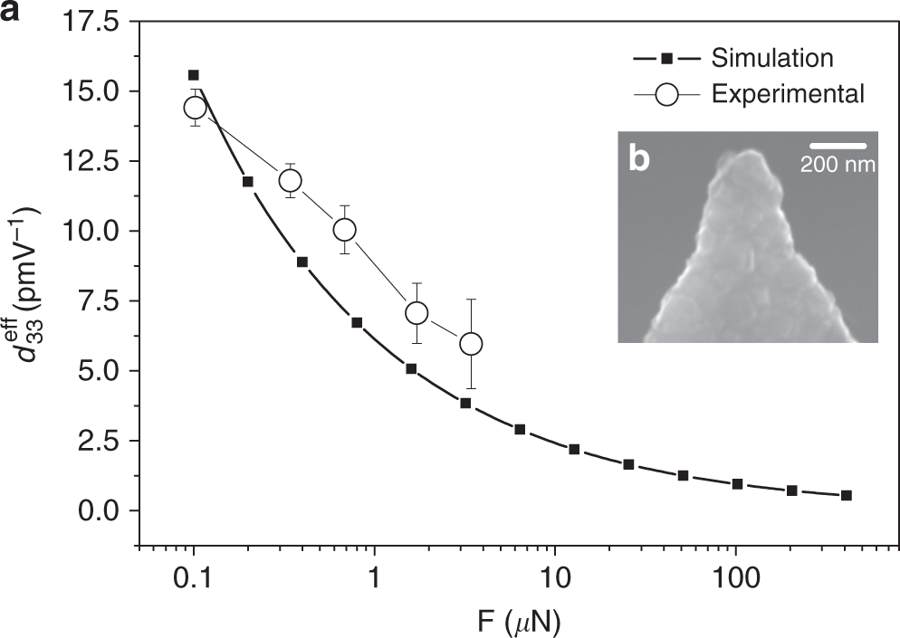NANOSENSORS™ conductive diamond coated CDT-NCLR AFM probes were used for the piezoresponse force microscopy ( PFM ) on non-piezoelectric dielectrics described in this brand new publication: “Converse flexoelectricity yields large piezoresponse force microscopy signals in non-piezoelectric materials” by Amir Abdollahi et al.
The autors show theoretically and experimentally, that large effective piezoelectric coefficients can be measured in non-piezoelectric dielectrics due to converse flexoelectricity.*

Figure 4 from “Converse flexoelectricity yields large piezoresponse force microscopy signals in non-piezoelectric materials” by Amir Abdollahi et al.:
Study of converse flexoelectricity induced at the tip apex of an atomic force microscope cantilever as a function of the applied force. a Effective piezoelectric coefficient as a function of applied force for the SrTiO3 crystal. Filled squares correspond to the values obtained after the simulation. Empty circles correspond to the experimental values obtained with a Nanosensors CDT-FMR tip with a cantilever of medium stiffness (k ≈ 2.8 Nm−1) coated with doped diamond. The error bars correspond to the error of the linear fitting of the experimental data, which correlates the measured electromechanical amplitude of oscillation Δh with the Vac applied voltage. b The effective contact radius a scales with the force, and is determined by the tip radius. The experimental tip radius is obtained after the measurement of the nanoscale electromechanical response from the scanning electron microscopy image of the used tip. In this case, the tip radius of the diamond coated tip is 105 nm, and is observed to keep a spherical shape after the measurements
*Amir Abdollahi, Neus Domingo, Irene Arias, Gustau Catalan
Converse flexoelectricity yields large piezoresponse force microscopy signals in non-piezoelectric materials
Nature Communicationsvolume 10, Article number: 1266 (2019)
DOI: https://doi.org/10.1038/s41467-019-09266-y
Please refer to this external link for the full article: https://www.nature.com/articles/s41467-019-09266-y
Open Access The article «Converse flexoelectricity yields large piezoresponse force microscopy signals in non-piezoelectric materials» by Amir Abdollahi et al. is licensed under a Creative Commons Attribution 4.0 International License, which permits use, sharing, adaptation, distribution and reproduction in any medium or format, as long as you give appropriate credit to the original author(s) and the source, provide a link to the Creative Commons license, and indicate if changes were made. The images or other third party material in this article are included in the article’s Creative Commons license, unless indicated otherwise in a credit line to the material. If material is not included in the article’s Creative Commons license and your intended use is not permitted by statutory regulation or exceeds the permitted use, you will need to obtain permission directly from the copyright holder. To view a copy of this license, visit http://creativecommons.org/licenses/by/4.0/.